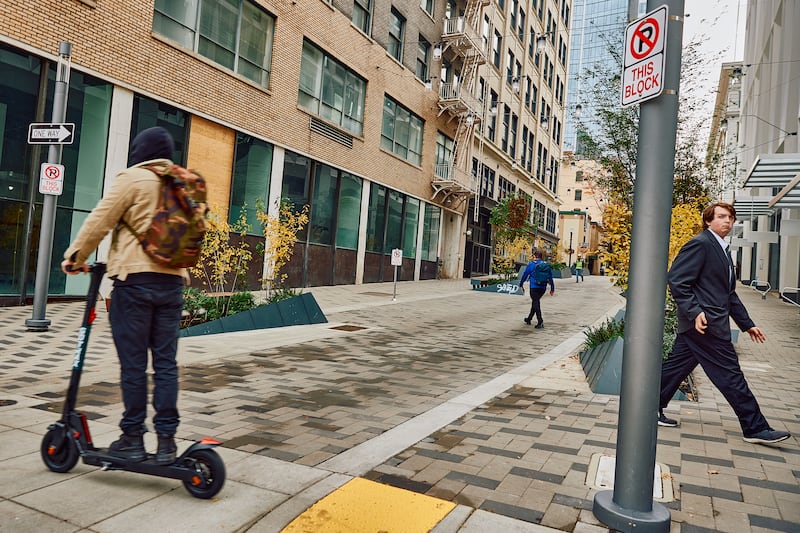Don’t fence me in.
That, very simply, was the recommendation from most members of the Portland Design Commission, the seven-member body that reviews major projects for the City Council, at a hearing on the proposed development of Darcelle XV Plaza yesterday.
Portland Parks & Recreation and its partner in the project, Downtown Portland Clean & Safe, want to turn the former O’Bryant Square, a blighted piece of downtown known at various times as “Needle Park” and “Paranoid Park,” into an event space, plaza and dog park.
They also want to surround the 100-by-200-foot property with a fence and close it at night, saying the moves are crucial to keep people from using the space to take drugs and relieve their bowels, problems that have made the space uninviting to most Portlanders.
The final decision lies with the parks bureau and City Commissioner Dan Ryan, who oversees the bureau. If approved, the park would be the first to be fenced in Portland outside of a collection of gardens, including the Portland Japanese Garden and the Crystal Springs Rhododendron Garden. Portland International Raceway and Walker Stadium in Lents Park, two events venues, are also fenced, a parks spokesman noted in an email. So is the upper field at Grant High School.
“It’s unpleasant to consider the presence of a fence,” Steve Wytcherley, director of operations at Downtown Clean & Safe, said at the hearing, “but we don’t have the resources to post someone over night.”
Members of the Design Commission used stronger language.
“You can’t just put a fence around a public space,” said commission vice chair Chandra Robinson, an architect at LEVER Architecture.
The design includes large gates that would be open from 6 am to 10 pm. Even so, a fence would deter people on the margins of society, Robinson said. “As a group of people who grew up with privilege, you feel welcome no matter what.” Others will be deterred by the fence, she added.
The design calls for a shorter fence around the dog park: 5 feet high instead of 6 feet, the height of the rest of the fence. Commissioner Zari Santner, a former director of Portland Parks & Recreation, said she “cringed” at that difference.
“[It seems] we want to make this park more welcoming for dogs than for people,” Santner said.
The parks bureau will consider the commissioners’ input, spokesman Mark Ross said in an email. “Portland Parks & Recreation attended the design commission meeting because we wanted input, and we appreciate the feedback received. We and Commissioner Ryan’s office will take it all into account as the planning process for the reimagined Darcelle XV Plaza interim project moves forward.”

Among the people who want the fence: Brian Owendoff, chief executive of BMO Commercial Real Estate and a representative for Walt Bowen, who owns the new 35-story Block 216 building at the southwest corner of the park. Block 216 has office space and a Ritz-Carlton hotel (11 floors) and Ritz-Carlton residences (the top 15 floors).
Owendoff wrote a letter to Ryan in July, arguing for a fence.
“There is an old saying that still holds true today,” Owendoff wrote. “‘Good fences make good neighbors.’ A fence will give City the ability to secure Park at night to avoid bad behaviors to occur after park hours (want to avoid past mistakes of O’Bryant Square).”
Owendoff also argued for a dog park, saying it would draw tourists.
“Portland has one of the highest dog ownerships of major US cities,” Owendoff wrote. “A simple off leash agility park would allow both Portland residents and tourist to City to bring their dog to the Park. This also becomes something tourist will enjoy watching, which I observed in several well designed and run City Parks.”
Something Owendoff and his client Bowen didn’t want: food carts. Block 216 has its own food hall, called Flock, and there are others in the area.
“Flooding the market with too many food venders will benefit no one,” Owendoff wrote.
Steven Lien, owner of underU4men, a clothing store across from the plaza, also wanted a “European-style” fence, a dog park, and no food carts, according to a letter he sent to Ryan the same day as Owendoff.
In the end, Owendoff, Bowen and Lien got what they wanted in the proposal. There’s a fence and dog park, and there are no food carts.
Darcelle XV Plaza is meant to last less than a decade. In that time, Portland Parks & Recreation and Clean & Safe are to figure out what works, then make something more permanent. The budget for the park is $7.2 million, much of which will come from system development charges, the fees that developers pay and that must be used for new parks, not for maintaining old ones.
The city started tearing up O’Bryant Square and demolishing the parking garage beneath it last spring. The square itself was originally named for Hugh Donaldson O’Bryant, a pioneer who migrated to Oregon from Georgia in 1843 and became Portland’s first mayor. In the early 1900s, the square was home to the Rivoli Theater and the Basket Grocery. The store closed in 1969. The owners donated the property to the city in 1971.

